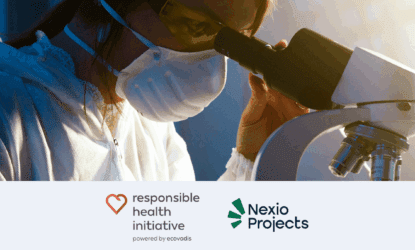 Understanding the Omnibus package and its potential impact
Understanding the Omnibus package and its potential impact
As anticipation grows around the upcoming EcoVadis 2025 updates, many of you submitted thoughtful questions about what’s changing and how to best prepare. From updates to the assessment methodology to practical implementation tips, your questions covered a wide range of important topics.
To make it easier to navigate, we’ve grouped the most frequently asked questions into key themes and provided clear, concise answers. Whether you’re just beginning your sustainability journey or are already familiar with EcoVadis, this blog will help you stay informed and confident about the road ahead.
Setting the context: Who are we?
Nexio Projects is your full-service sustainability partner, helping you navigate complexity and drive ambitious ESG action with confidence.
Trusted EcoVadis strategic partner
As a long-standing EcoVadis strategic partner since 2018, Nexio Projects supports companies across industries in improving their sustainability performance and strengthening their ratings. Recognised by Verdantix as one of the top 10 ESG and sustainability strategy consultancies worldwide, we offer expert guidance across the full EcoVadis journey — from onboarding to score optimisation.
Our experienced team of 30+ consultants helps you:
- Understand and navigate the EcoVadis methodology and scoring criteria
- Identify priority areas for improvement across Environment, Labour & Human Rights, Ethics, and Sustainable Procurement
- Build the internal processes and documentation needed to achieve and sustain strong performance
Let’s dive into your top questions — and our expert answers.
Policies & employee engagement
Is it necessary to obtain employee signatures or formal acknowledgment of company policies to achieve the highest score?
While not always mandatory, providing evidence that employees have received and acknowledged key policies (such as through signatures, digital confirmations, or training attendance records) strengthens your submission and can help achieve maximum points-especially for topics like Ethics and Labor & Human Rights. This demonstrates not just the existence of policies, but also their effective communication and implementation.
Scoring methodology & measures
How does the scoring for measures work? Is there a required number of measures per sub-theme, and how is the percentage of key sustainability issues addressed calculated?
To ensure meaningful reporting, there is a minimum requirement: companies must implement a certain number of measures across a defined number of activated criteria (also known as material topics). It is not necessary to have a measure for every possible sub-theme, but companies are expected to demonstrate coverage across the relevant issues identified in their assessment.
As a practical starting point, it is recommended that companies aim to have at least one relevant measure for each activated criterion. This approach is typically the most straightforward and effective in aligning with expectations.
For further clarity, please refer to Figure 1 / PCI’s measures and Figure 2 / EcoVadis scoring methodology for measures in the appendix, which provide a structured example of how measures are mapped to criteria and how coverage is evaluated.
Theme overlap & scoring impact
If a question is relevant to multiple themes, does it impact the score for each theme independently?
Yes, if a question or piece of evidence applies to multiple themes (for example, a supplier code of conduct relevant to both Ethics and Sustainable Procurement), it is considered in the scoring of each relevant theme. Strong evidence in cross-cutting areas can positively influence several theme scores.
Applicability of questions
What should we do if the questionnaire includes questions not relevant to our industry?
If you encounter questions that do not apply to your business model or industry, use the clarification or comment function in the EcoVadis platform to explain why the question is not applicable. Provide a clear justification and, where possible, supporting documentation. EcoVadis may adjust or remove the question from your scoring if your rationale is accepted. If the questionnaire is open, companies should contact EcoVadis afterwards to possibly review it. They can also use the comment section under General, on the question about general company overview.
Certifications & endorsements
How can small companies obtain certifications or endorsements without significant costs?
Small businesses can pursue cost-effective certifications through group schemes, local business associations, or by joining industry initiatives. Public endorsements, such as signing the UN Global Compact. There is an annual financial contribution required, which varies based on a company’s annual gross revenue and its country of operation. Participation in regional or sectoral sustainability programs can also serve as credible evidence for EcoVadis.
How should data be prepared to align with GRI Standards for EcoVadis evaluation?
Align your data collection and reporting with GRI Standards by focusing on material topics, quantitative KPIs, and clear narrative disclosures. Use GRI-compliant reports or data tables as evidence, ensuring consistency between public disclosures and your EcoVadis submission.
Documentation for biodiversity & environmental advocacy
What documentation is sufficient for topics like Biodiversity and Environmental Advocacy? How should companies with multiple divisions manage documentation?
Acceptable documentation includes policies, action plans, risk assessments, monitoring reports, certifications, and evidence of stakeholder engagement. For the measures section, companies with several divisions, you may submit division-level documents if group-level documents do not exist, but you must clarify the scope and relevance for each submission. Consistency and clarity about applicability are key.
Multi-site / Division management
What is the most effective way to improve the EcoVadis score and provide evidence when a company has sites with varying levels of maturity?
Standardise core policies and measures across all sites but highlight site-specific best practices and progress. Use group-level documentation where possible, supplemented by site-level evidence for key initiatives. Document continuous improvement and tailor evidence to reflect both group and local achievements.
Appeals & 360° Watch
What is the recommended process for appealing or challenging questions that did not receive credit, or for addressing inaccurate findings in the 360° Watch?
Use the EcoVadis appeal process to challenge scoring decisions or 360° Watch findings. Provide clear, factual evidence and a concise explanation. For 360° Watch, submit documentation of corrective actions or clarifications to demonstrate resolution or inaccuracy of the finding.
SME challenges
What are the main challenges for small and medium-sized enterprises (SMEs) aiming for strong EcoVadis scores?
SMEs often face resource constraints, less formalised documentation, and challenges in obtaining certifications. Overcome these by prioritising material issues, leveraging existing processes, using free or low-cost tools, and focusing on continuous improvement. Clear, well-organized documentation and communication of actions are essential.
2025 methodology updates to note
- Unrounded theme scores: From January 2025, theme scores are shown as unrounded values (e.g., 68.3/100), which are used for the overall score. This may result in minor changes to overall ratings.
- Theme weighting: The weighting of Environment, Labor & Human Rights, Ethics, and Sustainable Procurement depends on your industry and risk profile.
- Medals and Badges: Medals are now awarded based on percentile rankings among all rated companies, emphasizing continuous improvement to remain competitive.
- Stricter evidence requirements: Robust, up-to-date, and directly relevant documentation is more critical than ever for scoring well.
- Maximum score: Since 2025, to achieve maximum score, KPIs also need to be reported publicly, so sustainability reports are more important than ever. or you can incorporate this in the GRI question if more appropriate.
These answers reflect the latest EcoVadis 2025 methodology and expectations.
More of your questions
How can companies best prepare for EcoVadis 2025 scoring expectations?
Companies should update their sustainability policies, collect verified performance data, engage key suppliers, and benchmark prior assessments to address high-weight risk areas ahead of the 2025 cycle.
What is considered a ‘good’ EcoVadis score in 2025?
While thresholds vary by sector, scores above the 75th percentile within your industry are increasingly seen as strong, especially if supported by robust documentation and trend-based improvement.
When should companies start their preparatory work for EcoVadis 2025?
Preparation should begin at least 9–12 months before the assessment period to allow time for evidence collection, supplier engagement, and corrective action implementation.
How does supplier performance affect a company’s EcoVadis 2025 rating?
Supplier performance contributes significantly to a company’s overall rating through the ‘supply-chain’ theme; poor visibility or engagement with key suppliers can directly reduce your final score.
Have more questions? Contact us to see how we can support your organisation’s EcoVadis journey.











